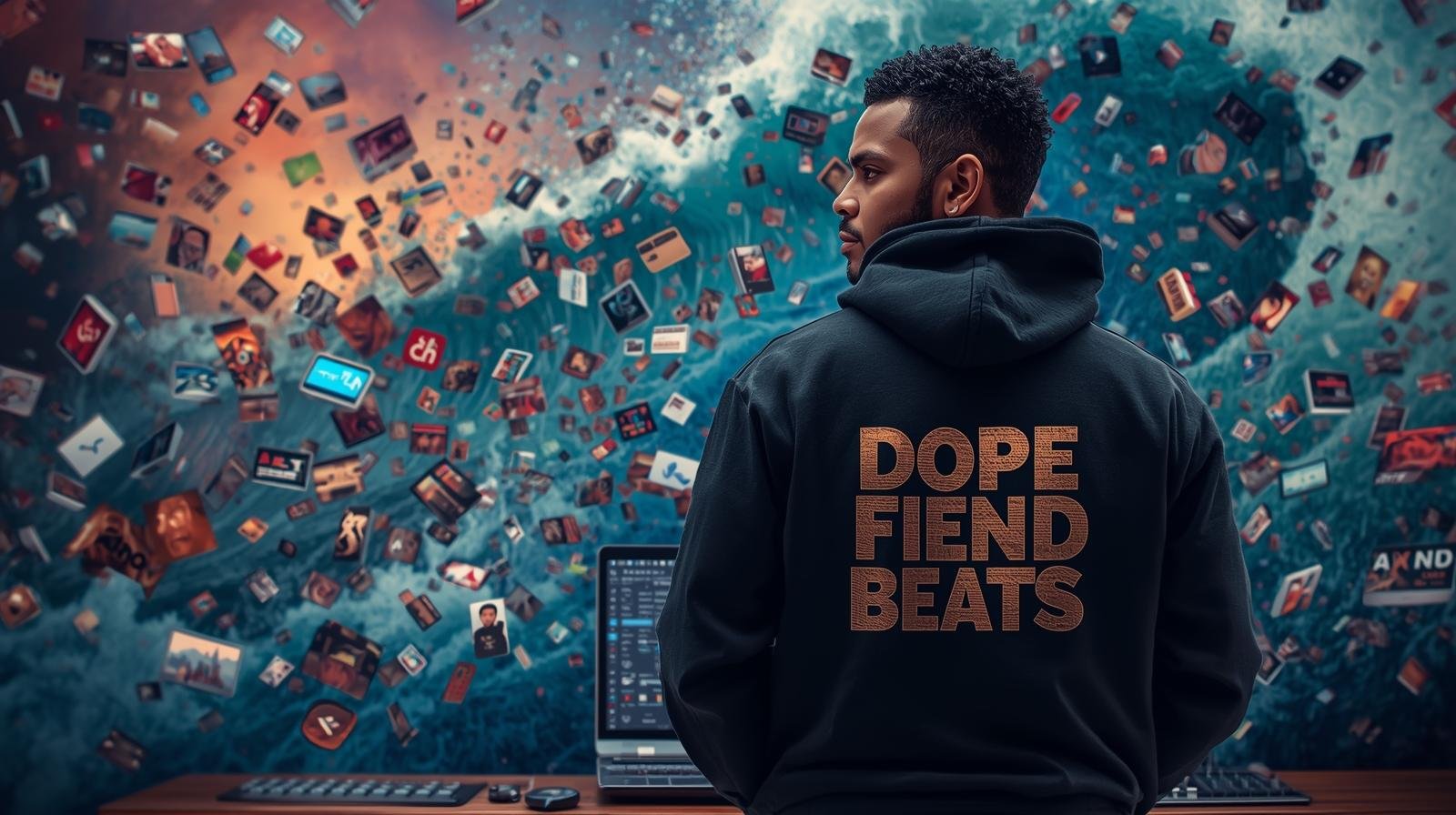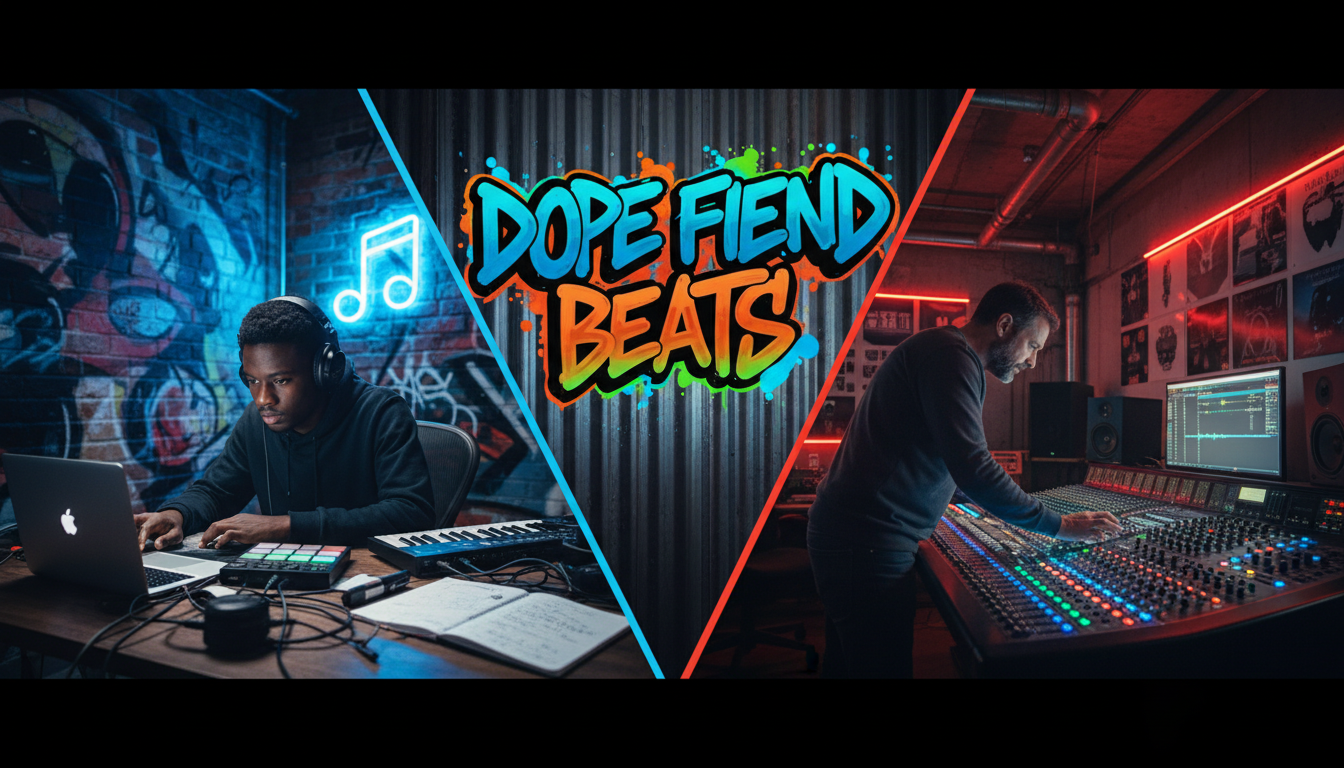When the Feed Never Ends
Why the explosion of AI-generated music on platforms like Deezer is both exciting and quietly unsettling for real artists and real listeners
Every day, an estimated 50,000 AI-generated tracks are uploaded to platforms like Deezer. That is not a typo. While you sleep, work, and scroll, algorithms are churning out more songs than a small country of producers could finish in a lifetime.
On paper, this sounds impressive. Infinite music on demand. No more silent playlists. Background vibes for every mood, task, or café. But from a human perspective, this flood of synthetic sound raises uncomfortable questions.
- What happens to meaning in music when most tracks were never felt, only computed?
- How do real producers compete with bots that never get tired and never need a split?
- As a listener, are you still choosing music, or is music simply being pushed at you, optimized for engagement but empty of experience?
For DOPE FIEND BEATS and anyone who cares about the soul behind the sound, it is time to take a deeper look at what this AI wave really means.
The Scale Problem: 50,000 New AI Tracks a Day
To understand how wild this is, imagine a human alternative.
- If a producer releases one track every week, that is about 50 tracks a year.
- At 50 tracks a year, it would take 1,000 human producers an entire year to release what AI can now generate in a single day.
Now, imagine a platform that already struggles with discovery for independent artists. Into that already crowded room, you drop millions of AI tracks per month, many made to be “good enough” background sound:
- Sleep music
- Lofi beats
- Mood playlists
- Study and focus tracks
- “Relaxing beats” with generic titles and similar cover art
From a business perspective, AI music is cheap, fast, and controllable. From a human perspective, that sheer volume can feel like white noise swallowing the personal voices.
How AI-Generated Tracks Feel to Human Listeners
Most listeners do not care whether a track is human-made or AI-made at first. They care about vibe.
But over time, many people report the same sensations when listening to heavily AI-fueled playlists:
1. Everything sounds “fine” but nothing sticks
AI is trained to predict the next note, chord, or drum hit that fits the style. The result often sounds:
- smooth
- familiar
- non-offensive
It is perfect for background listening. But music that stays in the background rarely moves your life forward. There is no story behind it, no struggle, no moment in the studio where someone almost deleted the beat and then changed one sound that made everything click.
The result is a strange emotional flatness. Tracks blend together. You remember the mood, but not the song.
2. Listeners become less patient
When you know there are millions of tracks at your fingertips, your tolerance for anything “imperfect” drops. A long intro, a risky chord change, an unusual drum pattern can feel like friction. AI music, trained on what keeps people from skipping, tends to eliminate friction.
This feeds a cycle:
- Listeners expect instant gratification.
- Platforms optimize for what gets fast engagement.
- AI models learn from this, creating even more surface-level tracks.
Risk-taking becomes rare. Yet risk is exactly where some of the most human music lives.
3. Emotional connection becomes more shallow
There is a difference between hearing a beat and feeling a beat.
- Human music often carries context: an artist’s story, community, struggle, or joy.
- AI music carries pattern recognition: the statistical average of thousands of similar tracks.
Listeners might still enjoy AI-generated sound, but the connection feels more like using a tool than sharing a moment with someone on the other end of the speaker.

What It Means for Human Producers and Beat Makers
For producers, especially those making instrumentals, lofi, or background-style beats, the AI flood feels personal. You are not just competing with other humans anymore. You are competing with:
- Systems that can generate infinite variations of “chill beats,”
- Companies that can own the masters outright with no negotiations,
- Algorithms that can be tuned to chase whatever sound is currently trending.
From a human perspective, a few real challenges emerge.
1. Discovery gets even harder
If a platform like Deezer receives tens of thousands of AI tracks a day, and countless human tracks on top of that, how does a new listener find you?
Even if your beats are better, more emotional, more unique, they can still get buried under endless algorithmic noise.
2. Financial pressure grows
For platforms, AI music is a cost-saving dream:
- No advances
- No royalties in many cases
- No legal or touring demands
If background playlists can be filled with AI for a fraction of the cost, that squeezes out human producers who rely on those lanes for income.
The harsh reality: the market price for “generic sound” is racing toward zero.
3. Identity matters more than ever
If AI can mimic almost any style, including your favorite drum swing or mix tone, then simply sounding good is not enough. Producers are being pushed to answer:
- Who am I as an artist?
- What do I stand for?
- What can I express that a model trained on data cannot?
The more AI music floods the platforms, the more human producers have to build a clear voice and story, not just a catalog.
The Listener’s Dilemma: Convenience vs. Connection
From the listener’s side, AI-generated music is extremely convenient.
- You press play.
- You get instant vibe, no awkward tracks, no emotional heavy lifting.
But convenience often comes with a cost: less intentional listening and less discovery of real human creators.
Background vs. foreground listening
There are two main modes of listening now:
- Background listening
- For work, study, sleep, or chores
- AI music thrives here, endlessly looping consistent moods
- Foreground listening
- When you really sit with a song
- When lyrics or melodies hit you in the chest
- When you replay the same track for weeks because it mirrors your life
The risk is not that AI kills foreground listening. The risk is that platforms slowly train people to spend most of their time in background mode, where music is more utility than art.
How Human-Centered Music Fights Back
Despite the flood, this moment might actually strengthen human-made music. It forces artists and listeners to wake up and make more conscious choices.
Here is how.
1. Producers double down on emotion and narrative
AI can simulate style. It cannot live a life.
Human producers can:
- Tell real stories behind tracks
- Show the process, the failures, the late nights
- Connect beats to specific moods, cultures, or movements
For a brand like DOPE FIEND BEATS, this might mean:
- Positioning beats as music for real people, not just algorithms
- Sharing the inspiration behind certain instrumentals
- Building collections like “Beats for healing,” “Beats for grind mode,” or “Beats for late-night reflection,” each tied to real human experiences
2. Community becomes the algorithm
Instead of depending only on platform algorithms, artists can lean into:
- Niche communities
- Discord servers, private groups, and mailing lists
- Collaborations, shout-outs, and curated human-made playlists
In this environment, word-of-mouth and community trust become the new discovery engine. If someone you respect says, “You need to hear this producer,” that cuts through a lot of AI noise.
3. Humans use AI as a tool, not a replacement
Some of the most powerful music coming soon will not be “human vs. AI” but human plus AI.
Producers can:
- Use AI for quick idea generation but edit with real taste and emotion
- Flip AI mistakes into unique sound design
- Build starting points with AI, then layer live instruments, personal samples, and human performance on top
The difference is intent. You are not letting AI define the track. You are using AI to expand your possibilities and then making very human choices.
What Platforms Owe to Real Artists and Real Listeners
From a human-centered view, platforms like Deezer have a responsibility to:
- Label AI music clearly, so listeners can choose consciously
- Set guidelines on how much AI content is injected into recommended feeds
- Ensure fair space and visibility for human-made tracks
- Share revenue fairly when AI training data uses human music as its foundation
Without this, we risk drifting into a future where human creativity becomes the raw material and AI-generated noise becomes the product.
How Listeners Can Support Human Music in an AI-Heavy World
You do not need to reject AI outright. But you can be intentional:
- Seek out playlists that highlight independent human producers.
- Follow and save tracks from artists you connect with.
- Share real music with friends instead of just letting autoplay run forever.
- Pay for music when you can: beat licenses, Bandcamp, merch, shows.
Every time you consciously choose a human track over a generic AI loop, you send a signal that soul still matters.
The DOPE FIEND BEATS Perspective: Soul Over Spam
In a world where 50,000 AI-generated tracks flood Deezer every day, standing out as a human creator is both harder and more important than ever.
For DOPE FIEND BEATS, that means:
- Crafting beats with intention, not just filling a category
- Honoring the culture and history behind hip-hop, lofi, and instrumental music
- Making soundtracks for real feelings, real grind, real healing
AI can flood the platforms with endless tracks. But it cannot wake up after a rough week, sit at the desk, and pour unresolved emotions into a beat that ends up helping someone else feel less alone.
That is still human territory.

- Deezer’s own announcement on AI detection and fake content
Deezer – Building a More Transparent and Fair Music Streaming Ecosystem - Deezer announces plans to detect AI-generated music and spam
Deezer – Protecting Artists in the Age of AI - Billboard – Deezer to identify AI-generated tracks and ghost streams
Billboard – Deezer to Target AI-Generated and Fraudulent Streams
(Some industry articles may mention specific daily upload numbers or estimates; if you quote “50,000 tracks per day,” frame it as an estimate or analysis rather than an official Deezer statistic unless directly sourced.)
2. AI and Music Industry Impact
- IFPI (International Federation of the Phonographic Industry)
IFPI – AI and Music: Position and Principles - MIDiA Research – Reports and blogs on AI in music
MIDiA Research – AI and the Future of Music - Rolling Stone – AI flood and concerns from artists
Rolling Stone – Musicians Are Worried About AI. They’re Right To Be
. Spam, Volume, and Discovery on Streaming Platforms
- Music Business Worldwide – Articles on upload volume and streaming clutter
Music Business Worldwide – Streaming & Oversupply - Goldman Sachs / industry reports quoted on track upload numbers
Music Business Worldwide – There Are Now Over 100,000 Tracks Uploaded Every Day to Streaming Services
4. Ethical and Legal Context Around AI-Generated Music
- EU and US discussions around AI and copyright
WIPO – Artificial Intelligence and Copyright - UMG and other labels’ reactions to AI music
Music Business Worldwide – Universal Music Group Calls on Streaming Services to Block AI Training on Its Catalog
5. Helpful Angles to Support Your Human Perspective
- The value of human creativity in the age of AI
Harvard Business Review – The Potential and Pitfalls of AI in Creative Work - Listener behavior and passive listening
Spotify Culture Next / fan studies – Passive vs Active Listening (search for “passive listening” or “background listening” articles)
How to Use These in Your Article
- Cite Music Business Worldwide for scale and upload volume.
- Cite Deezer’s blog and Billboard for AI-detection and anti-spam initiatives.
- Cite IFPI and WIPO for ethical and legal context.
- Use HBR / industry think pieces to support your human-centered, creative perspective.




